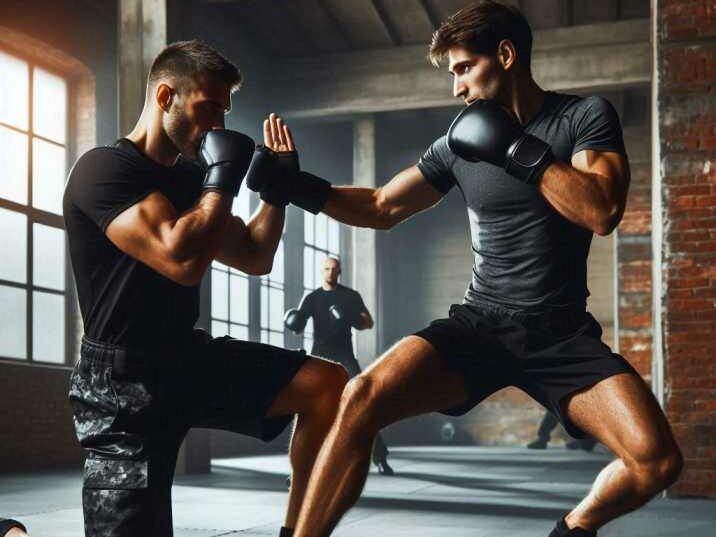Table of Contents
Table of Contents
- Introduction
- Krav Maga: The Art of Self-Defense
- A. Origins and History
- B. Techniques and Principles
- C. Training Methodologies
- D. Practical Applications
- Kickboxing: The Art of Striking
- A. Origins and History
- B. Techniques and Principles
- C. Training Methodologies
- D. Practical Applications
- Krav Maga vs Kickboxing: A Comparative Analysis
- A. Training Philosophies and Objectives
- B. Techniques and Skill Sets
- C. Training Intensity and Conditioning
- D. Practical Applications and Effectiveness
- Frequently Asked Questions (FAQs)
- Is Krav Maga or Kickboxing better for self-defense?
- Can I practice both Krav Maga and Kickboxing simultaneously?
- Which martial art is more physically demanding?
- Are Krav Maga and Kickboxing suitable for all ages and fitness levels?
- How long does it take to become proficient in Krav Maga or Kickboxing?
- Conclusion
Introduction:
Welcome to our in-depth comparison of Krav Maga vs Kickboxing, two popular martial arts disciplines known for their effectiveness in self-defense. Whether you’re a beginner seeking to learn a new skill or a seasoned martial artist looking to expand your knowledge, this blog post will provide you with a clear understanding of the differences and similarities between these two fighting styles. We’ll explore their origins, techniques, training methodologies, and practical applications to help you make an informed decision. So, let’s dive in!

Krav Maga: The Art of Self-Defense
Origins and History
The Birth of Krav Maga:
Krav Maga, meaning “contact combat” in Hebrew, was developed in the 1930s by Imi Lichtenfeld, a Hungarian-Israeli martial artist. It originated as a practical self-defense system for Jewish communities facing anti-Semitic attacks in pre-World War II Europe.
Influences and Evolution:
Imi Lichtenfeld drew inspiration from his background in boxing, wrestling, and various street fighting experiences. He later refined and adapted these techniques to create a comprehensive self-defense system suitable for real-life scenarios. Over the years, Krav Maga has evolved and incorporated techniques from other martial arts, such as judo and jujitsu, to enhance its effectiveness.
Techniques and Principles
Striking Techniques:
Krav Maga emphasizes efficient and powerful strikes to vulnerable targets, including punches, elbows, knees, and kicks. The techniques are designed to incapacitate an attacker quickly and effectively.
Joint Locks and Manipulations:
Krav Maga incorporates joint locks, joint manipulations, and pressure points to control and subdue an opponent. These techniques allow practitioners to neutralize threats without causing excessive harm.
Defensive Maneuvers:
Krav Maga teaches a variety of defensive maneuvers, including blocks, parries, and evasive footwork. These techniques help practitioners avoid incoming attacks and create opportunities for counter-attacks.
Ground Fighting and Escapes:
Krav Maga recognizes the importance of ground fighting skills in real-life self-defense situations. It teaches techniques for escaping from various positions, defending against ground attacks, and quickly regaining a standing position.
Training Methodologies
Realistic Scenarios and Stress Training:
Krav Maga training emphasizes realistic scenarios to simulate real-life threats. Practitioners train in high-stress environments, facing multiple attackers and adverse conditions, to develop the ability to think and act under pressure.
Emphasis on Practicality and Efficiency:
Krav Maga focuses on practical techniques that can be easily learned and applied by individuals of all ages and fitness levels. The system prioritizes efficiency and effectiveness over flashy or complicated moves.
Use of Protective Gear and Equipment:
To ensure safety during training, Krav Maga utilizes protective gear and equipment, such as headgear, gloves, mouthguards, and groin protectors. This allows practitioners to train with full force and realistic intent while minimizing the risk of injury.
Practical Applications
Self-Defense in Real-Life Situations:
Krav Maga’s primary objective is to equip individuals with the skills and mindset needed to protect themselves in real-life self-defense situations. It focuses on practical techniques that can be applied quickly and effectively against various types of attacks.
Military and Law Enforcement Training:
Krav Maga is widely used in military and law enforcement training worldwide. Its emphasis on practicality, efficiency, and adaptability makes it a valuable tool for professionals who face high-risk situations and need effective self-defense skills.
By understanding the origins, techniques, training methodologies, and practical applications of Krav Maga, individuals can gain insight into why it has become a popular choice for self-defense and professional training. Its focus on real-life scenarios, practical techniques, and stress training sets it apart as a highly effective self-defense system.
Kickboxing: The Art of Striking
Origins and History
Traditional Martial Arts Influences:
Kickboxing has its roots in various traditional martial arts, with influences from disciplines such as Muay Thai, Karate, and Western Boxing. These martial arts provided the foundation for the techniques and principles that make up modern kickboxing.
Development of Modern Kickboxing:
Modern kickboxing as we know it today emerged in the 1960s and 1970s when martial artists sought to create a combat sport that combined the striking techniques of traditional martial arts with the competitive elements of Western boxing. This led to the development of organized kickboxing competitions and the establishment of governing bodies to regulate the sport .
Techniques and Principles
Punches and Strikes:
Kickboxing incorporates a wide range of punches, including jabs, hooks, uppercuts, and crosses. These techniques are executed with proper body mechanics and aim to generate power and accuracy in striking.
Kicks and Knee Strikes:
Kicks are a fundamental aspect of kickboxing, with techniques such as roundhouse kicks, front kicks, side kicks, and spinning kicks being commonly used. Knee strikes, both to the body and head, are also prominent in kickboxing, adding versatility to the striking arsenal.
Footwork and Movement:
Footwork and movement play a crucial role in kickboxing, enabling practitioners to maintain balance, create angles, and evade incoming strikes. Proper footwork allows fighters to control distance, set up attacks, and defend against opponents effectively.
Training Methodologies
Focus on Conditioning and Fitness:
Kickboxing training places a significant emphasis on conditioning and overall fitness. Workouts often include cardiovascular exercises, strength training, and endurance drills to develop the necessary physical attributes required for the sport.
Sparring and Pad Work:
Practitioners engage in sparring sessions with partners to practice techniques, timing, and defensive skills. Pad work, where trainers hold focus pads for fighters to strike, allows for precise targeting, speed development, and combination training.
Competition and Sport-Oriented Training:
Kickboxing training often involves specific drills and strategies tailored for competitive bouts. Fighters learn to adapt their techniques and tactics to adhere to the rules and regulations of the sport, focusing on scoring points, defense, and ring control.
Practical Applications
Self-Defense in Stand-Up Fights:
Kickboxing techniques can be applied effectively in real-life self-defense situations, particularly in stand-up fights. The striking techniques, footwork, and defensive skills learned in kickboxing training provide individuals with the ability to defend themselves against attackers in close-quarters combat.
Kickboxing as a Combat Sport:
Kickboxing has gained popularity as a combat sport worldwide, with various organizations hosting professional competitions. These events showcase the skills, athleticism, and strategy involved in kickboxing, providing athletes with an avenue to test their abilities and compete against other skilled fighters.
By delving into the origins, techniques, training methodologies, and practical applications of kickboxing, individuals can gain a comprehensive understanding of this striking-focused martial art. Its combination of punches, kicks, and knee strikes, along with its focus on conditioning and sport-oriented training, make kickboxing an effective choice for both self-defense and competitive endeavors.
Krav Maga vs Kickboxing: A Comparative Analysis
Training Philosophies and Objectives
Self-Defense vs Sport-Focused Training:
Krav Maga’s primary focus is on practical self-defense techniques that can be applied in real-life situations. It emphasizes neutralizing threats quickly and efficiently, with an emphasis on survival. On the other hand, kickboxing often has a sport-oriented approach, with training geared towards competition and defeating opponents within the controlled environment of a ring.
Real-Life Scenarios vs Controlled Environment:
Krav Maga training incorporates realistic scenarios and stress drills to prepare practitioners for real-life self-defense situations. It aims to develop the ability to react effectively under high-pressure circumstances. Kickboxing, while providing valuable striking skills, is primarily practiced within the controlled environment of a gym or ring, with rules and regulations governing the techniques and conduct of the sport.
Techniques and Skill Sets
Striking Techniques:
Both Krav Maga and kickboxing involve striking techniques, but they differ in their approach. Krav Maga focuses on practical strikes that target vulnerable areas of the body, aiming to incapacitate an attacker quickly. Kickboxing, on the other hand, emphasizes a wider range of striking techniques, including punches, kicks, and knee strikes, with an emphasis on scoring points in competition.
Defense and Counter-Attacks:
Krav Maga places a strong emphasis on defensive techniques, teaching practitioners how to defend against various types of attacks and quickly transition to counter-attacks. Kickboxing also includes defensive techniques, but they are often geared towards evading strikes and creating openings for counter-attacks within the context of a sport-oriented competition.
Ground Fighting Abilities:
Krav Maga incorporates ground fighting techniques and escapes, recognizing the importance of self-defense in close-quarters situations. Kickboxing, on the other hand, primarily focuses on stand-up fighting and does not typically include extensive ground fighting training.
Training Intensity and Conditioning
Stress Training and Realistic Drills:
Krav Maga training often involves stress drills and realistic scenarios to simulate the intensity and unpredictability of real-life self-defense situations. This type of training helps develop mental fortitude, decision-making skills, and the ability to perform under pressure. Kickboxing training, while physically demanding, may not incorporate the same level of stress training and scenario-based drills.
Fitness and Physical Demands:
Both Krav Maga vs kickboxing require a certain level of physical fitness. However, kickboxing training often places a greater emphasis on conditioning, as it is a combat sport that requires athletes to have high levels of cardiovascular endurance, strength, and agility. Krav Maga training focuses on functional fitness and developing the specific skills needed for self-defense situations.
Practical Applications and Effectiveness
Assessing Real-Life Self-Defense Situations:
Krav Maga’s training methodology, which includes realistic scenarios and stress drills, aims to prepare practitioners for real-life self-defense situations. It focuses on practical techniques that can be applied effectively in dangerous encounters. Kickboxing, while providing valuable striking skills, may not have the same level of emphasis on real-life self-defense scenarios.
Adapting Techniques to Personal Needs:
Both Krav Maga and kickboxing offer techniques that can be adapted to personal needs and circumstances. Krav Maga’s focus on practicality and efficiency allows practitioners to tailor techniques to their specific situations. Kickboxing techniques can also be adapted, but they are often practiced within the context of sport-oriented competition.
ConclusionIn
In conclusion, The Ultimate Showdown Krav Maga vs Kickboxing. both Krav Maga and kickboxing offer unique advantages in the realm of self-defense and combat sports. Krav Maga focuses on real-life scenarios, practical techniques, and stress training, making it an excellent choice for those seeking self-defense skills applicable in dangerous situations. On the other hand, kickboxing emphasizes striking techniques, conditioning, and sport-oriented training, making it ideal for those looking to compete or enhance their fitness level. Ultimately, the choice between Krav Maga and kickboxing depends on individual goals, preferences, and personal circumstances. We hope this comprehensive comparison has provided you with valuable insights to make an informed decision.
Frequently Asked Questions (FAQs)
Q. Is Krav Maga or Kickboxing better for self-defense?
The choice between Krav Maga and kickboxing for self-defense depends on personal preferences and goals. Krav Maga focuses specifically on practical self-defense techniques applicable in real-life situations, while kickboxing offers striking skills within a sport-oriented context.
Q. Can I practice both Krav Maga and Kickboxing simultaneously?
It is possible to practice both Krav Maga and kickboxing simultaneously, as they offer different skill sets and training approaches. However, it is important to manage training schedules and ensure that the techniques and principles of each discipline are not confused or mixed inappropriately.
Q. Which martial art is more physically demanding?
Kickboxing training often places a greater emphasis on physical conditioning, as it is a combat sport that requires high levels of cardiovascular endurance, strength, and agility. Krav Maga training also requires physical fitness but may focus more on functional fitness and specific self-defense skills.
Q. Are Krav Maga and Kickboxing suitable for all ages and fitness levels?
Both Krav Maga and kickboxing can be adapted to suit different ages and fitness levels. However, it is important to consult with instructors and trainers to ensure that training is appropriate and tailored to individual capabilities and goals.
Q. How long does it take to become proficient in Krav Maga vs Kickboxing?
The time it takes to become proficient in Krav Maga or kickboxing varies depending on individual dedication, training frequency, and natural aptitude. Proficiency in either discipline typically requires consistent training over a period of months or years.


